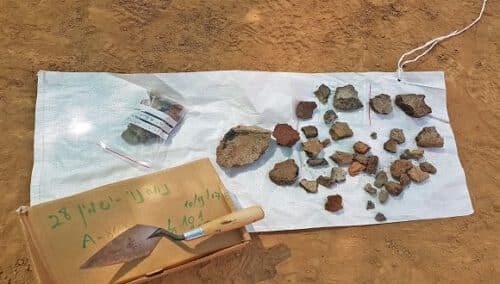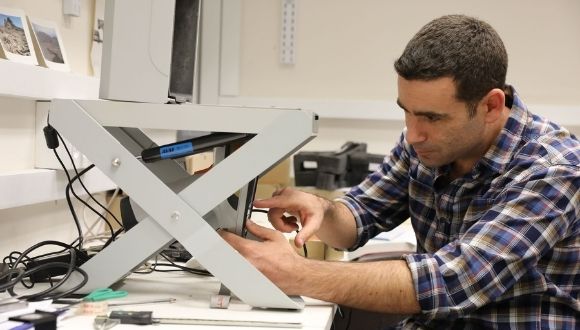Researchers have uncovered a 6,500-year-old workshop for copper production in the city
It turns out that Be'er Sheva, the bearer of the title 'Capital of the Negev and the South', which centers around the region's population and boasts high-tech and shopping centers, a bustling industrial area and a football team in the Premier League, was already considered thousands of years ago no less than a regional powerhouse in an innovative industrial production branch - copper. A new study by Tel Aviv University and the Antiquities Authority reveals that in the Neve Noi neighborhood in Be'er Sheva, one of the oldest copper production workshops in the world operated. Now the hypothesis is being tested as to whether the Be'er Shavet metal potters were the first to use the revolutionary device - the furnace.
A surprise in an archaeological rescue
This is a study that began with the discovery of the workshop in 2017, in the archeological rescue excavations of the Antiquities Authority in the city. The research was conducted by Dana Akerfeld, Omri Yigal and Prof. Erez Ben Yosef From the Department of Archeology and Ancient Near Eastern Cultures by Yaakov M. Alkov, in collaboration with Dr. Yael Abadi-Reis, Talia Abulfia and Dimitri Yegorov from the Antiquities Authority and Dr. Yehudit Harlevan from the Israel Geological Survey. The results of the groundbreaking research were published in the prestigious Journal of Archaeological Science: Reports.
According to Talia Abulfia, the director of the excavation on behalf of the Antiquities Authority, "the excavation revealed evidence of domestic industry from the Chalcolithic period, about 6,500 years ago. This is about the copper and stone age, when metalworking already existed, but the tools they used were still stone tools. The surprising findings included, among other things, a small copper smelting workshop with fragments of mines - small bowls made of clay in which the copper lead was melted, as well as many copper slags."
Regional technological experts
An isotopic analysis of the ore remains in the fragments of the furnaces shows that the raw material for the production of the metal in the Neve Noi neighborhood came from the Wadi Pinan area in present-day Jordan - a distance of more than 100 km from Beer Sheva. In the Chalcolithic period, when copper was produced for the first time, the metal was produced away from the mines, in contrast to the method prevalent throughout history, in which, for practical and economic reasons, the furnaces were built adjacent to the mines. The researchers estimate that the reason for this was keeping the technological secret.
"You have to understand that copper production was the high-tech of that time, and there is no more sophisticated technology than this in the ancient world," emphasizes Prof. Erez Ben Yosef. "If we just throw lumps of ore into the fire - nothing will happen. Certain knowledge is needed for the production of special furnaces, which can reach high temperatures and at the same time - maintain a low amount of oxygen."

Stone tools uncovered in the excavation in Neve Noi. Photo: Anat Rasiuk, Antiquities Authority
The quarter of the metal manufacturers
Prof. Ben Yosef points out that in the archeology of the Land of Israel there is evidence of a culture called the Essol culture, named after the archaeological site in Jordan, Essol Mounds, where it was first identified. This culture, which stretched from the Be'er Sheva Valley to southern Lebanon, is exceptional in its achievements in the field of art and worship, and it is enough to look at the wonderful copper objects found in the Nahal Mishmar cache and displayed today in the Israel Museum.
According to him, the people who lived in the Arabah traded with the people of the Esuli culture from Be'er Sheva and sold them the ore, but they themselves did not know how to reproduce the magic. "Even within the Hasuli settlement along Nahal Beer Sheva, the copper was produced in special workshops by experts, when the chemical analysis of the remains shows that each workshop kept the specific 'recipe' for itself and did not share it with the others. Nahal Beer Sheva was probably a flowing stream at the time, so the environment was favorable for copper workshops, whose furnaces and other facilities are made of material."
According to Prof. Ben Yosef, even within the Chalcolithic settlements, that is, within the settlements that had both stone vessels and copper vessels, the magic of the shiny material was reserved for a few, the members of the elite. "At the beginning of the metallurgical revolution, the metal revolution, the secret of the metal was kept among 'guilds' of experts. All over the world we find a kind of quarters of metal producers within the Chalcolithic settlements, like the quarter we find in Be'er Sheva."
Clear classes and art for the elite
In the research, there is a lively discussion on the question of how hierarchical and socially stratified this society was, since it is still not an urban society but a rural one. The researchers believe that the findings in Neve Noi strengthen the social stratification thesis, which holds that it is a complex society with a distinguished elite with professional specialties and secrets, which maintained its power by producing the shiny material - copper.
"The copper tools that were produced were not useful, they had a symbolic meaning. A copper ax was not used as an axe, it was an artistic and ritual imitation of the stone axe. The metal objects were used in worship, while in everyday life the use of stone tools continued," explains Prof. Ben Yosef.
Was the first furnace made in Israel?
In the first phase of copper production in the world, we don't find furnaces, we find mines," says Prof. Ben Yosef. "It's a small pottery vessel made of material that looks like a flower pot, a kind of portable kiln that is based on coal. Here, in Neve Noi's copper workshop, we show that the technology was based on real furnaces. This is very early evidence of the use of furnaces for metallurgy, and it raises the possibility that the furnace was invented in our area. It is also possible that the furnace developed elsewhere, and directly from mine-based metallurgy, since some researchers see the first furnaces as nothing more than large mines stuck in the ground. We will leave the decision on the matter to future discoveries, but there is no doubt that ancient Be'er Sheva had an important contribution to the advancement of the global metal revolution, and that in the 5th millennium BC it was a technological powerhouse of the entire region."


One response
"The fifth millennium BC" - I'm sorry for showing ignorance, but it goes back 7000 years, or did you mean 2000 AD plus 3000 before it...?